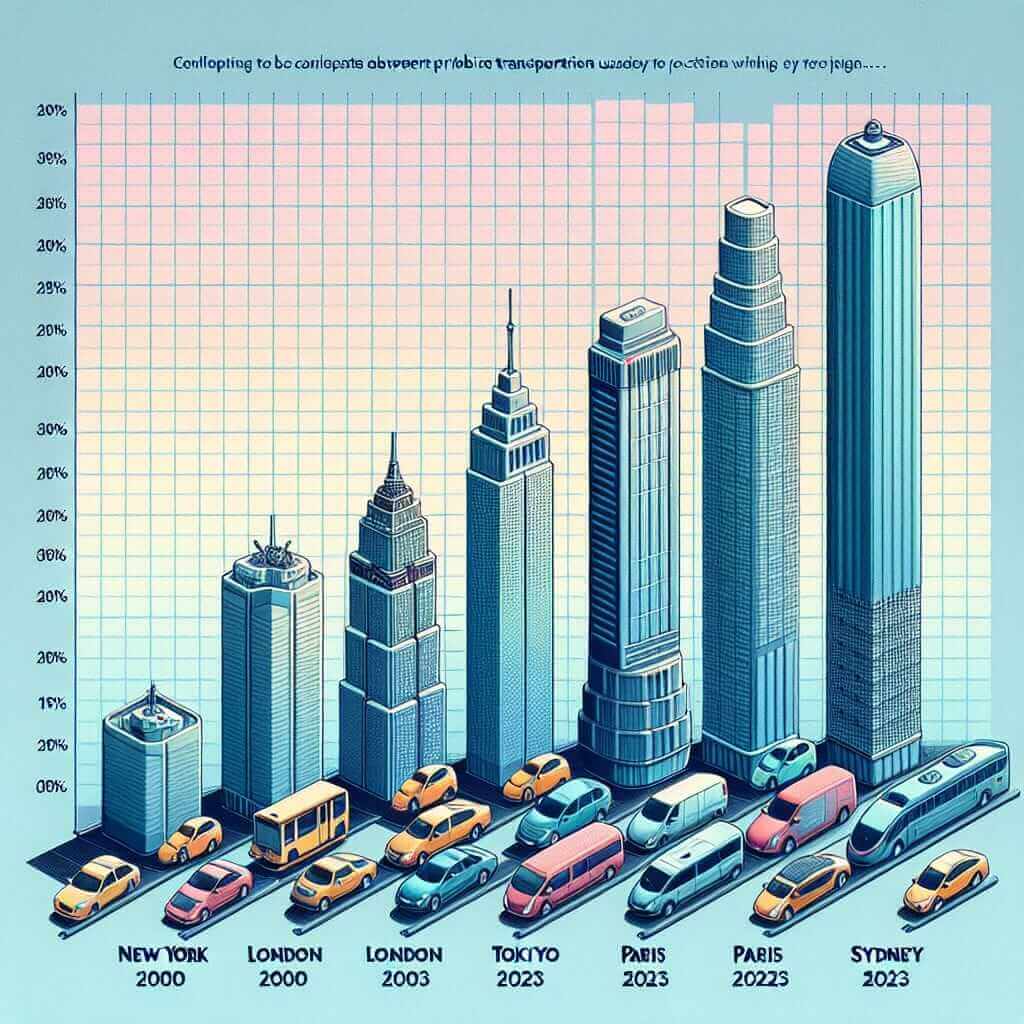Transport systems are essential elements of urban infrastructure, and their usage patterns have significant implications for the environment, economy, and quality of life in cities. In the IELTS exam, especially in the Writing Task 1, candidates often encounter topics that require them to describe and analyze data from charts, graphs, or tables related to public and private transport usage. This analysis must be well-structured and informative to score high marks.
In this lesson, we will explore the topic “Public vs Private Transport Usage in Major Cities (2000-2023)” and create practical examples for IELTS Writing Task 1. We will also discuss essential vocabulary, grammar, and writing tips to help you achieve a higher band score.
Task 1 Sample Topics
Below are some sample IELTS Writing Task 1 topics related to public and private transport usage in major cities:
- The bar chart shows the proportion of public and private transport usage in five major cities from 2000 to 2023.
- The line graph illustrates the trend of public and private transport usage in Europe and North America between 2000 and 2023.
- The table compares the percentage of public transport and private car usage in ten major cities over the period from 2000 to 2023.
For this lesson, we will focus on the first topic and create a bar chart to provide data for our analysis.
Data Presentation
Sample Bar Chart
The bar chart below shows the proportion of public and private transport usage in five major cities (New York, London, Tokyo, Paris, and Sydney) from 2000 to 2023.
Bar Chart: Public vs Private Transport Usage
| City | Public Transport (2000) | Public Transport (2023) | Private Transport (2000) | Private Transport (2023) |
|---|---|---|---|---|
| New York | 60% | 70% | 40% | 30% |
| London | 55% | 65% | 45% | 35% |
| Tokyo | 50% | 55% | 50% | 45% |
| Paris | 40% | 50% | 60% | 50% |
| Sydney | 30% | 40% | 70% | 60% |

Analysis of the Task
Let’s break down the task using the bar chart provided:
- Overview: Summarize the main trends or significant changes observed in the data.
- Body Paragraph 1: Describe the data for public transport usage in the given cities in 2000 and 2023.
- Body Paragraph 2: Describe the data for private transport usage in the given cities in 2000 and 2023.
Sample Writing
Overview
The bar chart illustrates the proportions of public and private transport usage in five major cities from 2000 to 2023. Overall, public transport usage has increased in all the cities, while private transport usage has decreased over the same period.
Body Paragraph 1
In 2000, public transport was predominantly used in New York, with 60% of the population relying on it, and this figure increased to 70% by 2023. Similarly, London saw an increase in public transport usage from 55% in 2000 to 65% in 2023. Tokyo experienced a more modest rise from 50% to 55%. Paris also showed a significant increase, with public transport usage climbing from 40% to 50%. Sydney, although starting at a low point, had public transport usage rise from 30% in 2000 to 40% in 2023.
Body Paragraph 2
Conversely, the data for private transport usage reveals a declining trend across all cities. In New York, private transport usage decreased from 40% in 2000 to 30% in 2023. London followed a similar pattern, dropping from 45% to 35%. In Tokyo, private transport usage slightly decreased from 50% to 45%. Paris also saw a notable reduction, with private transport usage falling from 60% to 50%. Sydney, which initially had the highest private transport usage at 70%, saw a reduction to 60% by 2023.
Word Count: 202
Tips for Writing
-
Vocabulary:
- Use varied vocabulary to describe increases (e.g., rise, climb, grow) and decreases (e.g., fall, drop, decline).
- Use comparative language to show contrasts and trends (e.g., more than, less than, compared to).
-
Grammar:
- Ensure correct use of tenses. Describe past trends with the past simple tense and ongoing trends up to the present with the present perfect tense.
- Use appropriate conjunctions and linking words to connect ideas smoothly.
-
Structure and Cohesion:
- Start with an overview that summarizes the main trends.
- Organize the body paragraphs logically, focusing on different aspects of the data.
- Use clear and concise language.
Important Vocabulary
- Proportion (noun) /prəˈpɔːrʃn/: the number or amount of a group or part of something compared to the whole.
- Trend (noun) /trend/: a general direction in which something is developing or changing.
- Predominantly (adverb) /prɪˈdɒmɪnəntli/: mainly; for the most part.
- Significant (adjective) /sɪɡˈnɪfɪkənt/: sufficiently great or important to be worthy of attention.
- Decline (verb) /dɪˈklaɪn/: decrease in the number, value, quality, etc.
Conclusion
When tackling an IELTS Writing Task 1 question related to public vs private transport usage, it is important to structure your response clearly, provide a succinct overview, and describe the trends in detail. Practicing with real-world data and varied vocabulary can significantly enhance your ability to perform well in the exam. Aim to be clear, concise, and precise to achieve a band score of 7 or higher.